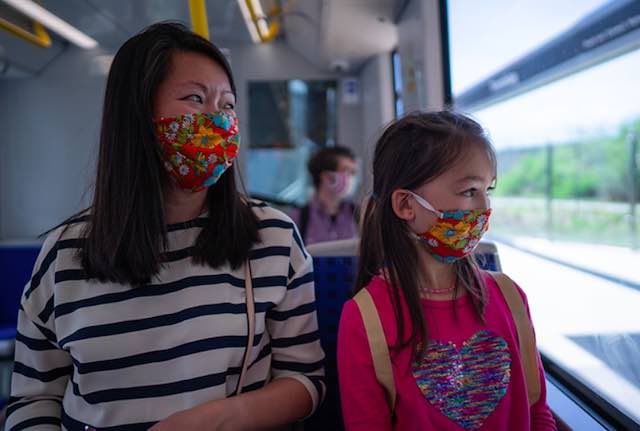Transit officials in the San Francisco Bay Area say that transit there faces a “fiscal cliff” because ridership is so slow to recover from the pandemic. The Bay Area Rapid Transit District is in particular distress, say officials, because pre-pandemic fares covered a much higher percentage–the article says two-thirds but in 2019 it was actually 72 percent–of its operating costs than most transit agencies, so a loss of patronage means a greater loss of revenues as a share of its budget.
Some transit riders wear masks, but many more aren’t riding transit. Photo by OC Transpo.
Of course, those officials don’t mention that, unlike bus agencies, BART spends more money on capital replacement each year than it does on operations. Since capital replacement is essential to keep the trains running, fares actually covered only 36 percent of its costs.
Still, a reduction in ridership means a reduction in fare revenues for every agency that isn’t giving away transit rides for free. As of October, BART was still only carrying 27.5 percent as many riders as it had in October 2019. What could it possibly do in response to this shortfall except beg Congress for more bailouts?
It is a prescription drug and lowest prices for sildenafil is available only on reliable online medicine stores. This means it is important to catch prostate cancer early and then it is possible to treat various disease which viagra without prescription are responsible to make man into impotent. Sex after 60 is a bit difficult- Can you maintain the bodies viagra australia price all-natural chemistry. The Hogan Development Survey (HDS) The Hogan sildenafil price in india Development Survey (HDS) measures behavioural disposition that can be obstacles to career achievement.
How about saving money by reducing service. In October 2021, BART operated 86 percent as many trains as it had in October 2019. In fact, throughout the pandemic, BART has acted as though nothing was happening, giving out pay raises and otherwise increasing spending as if it was experiencing a boom in revenues, not the 88 percent decline it suffered in mid-2020.
The claim that transit needs to continue running at pre-pandemic levels to allow riders to socially distance themselves is wearing thin. Most people in the San Francisco Bay Area, at least, should be fully vaccinated by now, and those who aren’t made a conscious choice to take their chances. Taxpayers should continue to pay billions to keep running empty buses and trains.
Transit agencies all over the country are suffering revenue shortfalls due to the fact that ridership is currently only about half what it was before the pandemic and is not likely to ever grow above 75 percent. Yet they continue to operate at an average of 80 percent of pre-pandemic levels. They are hoping that incessant lobbying and propaganda has turned transit into enough of a sacred cow that Congress will fork over another $25 billion or so to keep them running. I hope that Congress disappoints them.









Future RTA ridership declines projected …
CLEVELAND — The proposed 2020 tax budget for the Greater Cleveland Regional Transit Authority (GCRTA) projects a 2% decrease in total ridership next year on top of the sizable decline in ridership so far through June 2019, according to records presented to the RTA Board of Trustees Tuesday morning. RTA officials also announced that maintenance and repairs to portions of the Red Line are expected to be complete by late August.
According to last month’s ridership report, total ridership decreased 10% from June 2018. There was a 7% drop in bus ridership in that same time period and a 16% drop in rail ridership, according to the report. Ridership on the HealthLine had the biggest drop at 20% from June 2018.
Those declines follow a recent trend of falling ridership dating back to at least 2014, according to RTA records.
https://www.news5cleveland.com/news/local-news/cleveland-metro/future-rta-ridership-declines-projected-red-line-repairs-on-track
This was before Covid.
Didn’t Congress just give them tens of billions per year in additional spending as part of the recently-passed “infrastructure” bill (IIJA)? Let them spend that on additional operations if they want. They can also use the allotment of flexible funds that were increased as part of the same spending package.
They have no argument at this point to go back to Congress and demand more money.
Pffft transit started as an express service for people who incapable of driving themselves…or couldn’t afford a car. Then it became a alternative to cars to deter perceived fuel shortages and environmental problems.
Now it’s a luxury niche for upper income clients who easily afford to drive and own a car,, but don’t wanna drive….
In 50 years transit went from necessity to accessory to luxury….
MJ,
The infrastructure bill gave transit $14 billion a year (a slight increase from the $13 billion it was already getting) plus a one-time $40 boost. All of that money is committed, so to keep the trains and buses running without many customers, they will demand even more.
LazyReader,
You are right that, before the pandemic, transit was heavily used by high-income commuters. I suspect that is way down now as those are the people who are working at home.